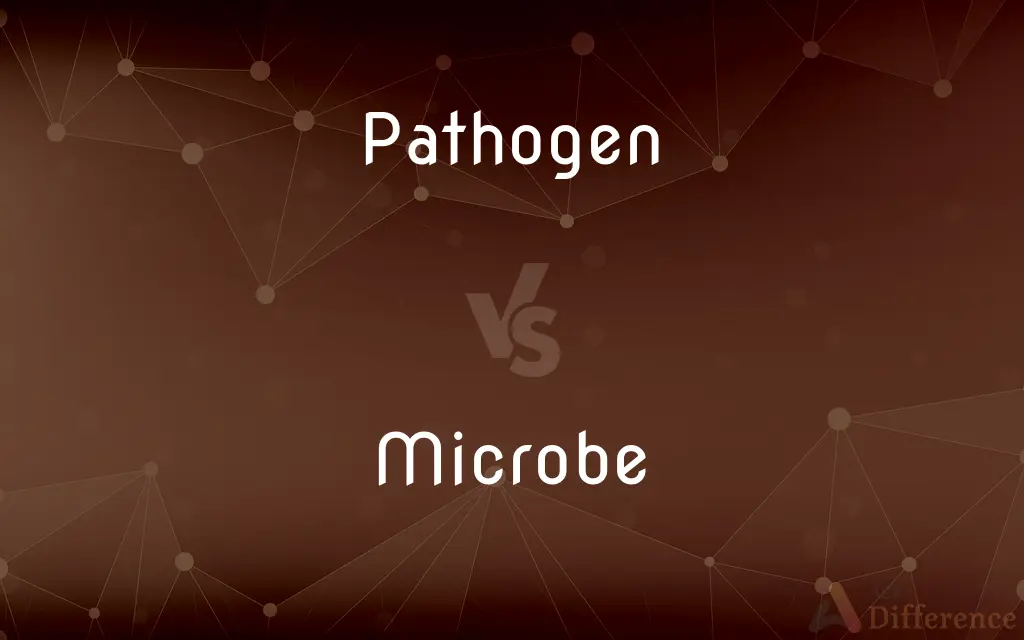Pathogen vs. Microbe — What's the Difference?
Edited by Tayyaba Rehman — By Urooj Arif — Updated on March 26, 2024
Pathogens are harmful organisms causing diseases, while microbes are diverse, including both harmful and beneficial microorganisms.

Difference Between Pathogen and Microbe
Table of Contents
ADVERTISEMENT
Key Differences
Pathogens refer to microorganisms or agents that cause diseases in their hosts, including bacteria, viruses, and fungi. They are characterized by their ability to invade and damage tissues, triggering an immune response. On the other hand, microbes, or microorganisms, encompass a broad range of tiny life forms, including bacteria, viruses, fungi, and protozoa. Not all microbes are harmful; many play essential roles in processes such as decomposition, fermentation, and the global cycling of nutrients.
Pathogens are a subset of microbes, specifically those that are harmful to other living organisms. The relationship between pathogens and their hosts is often described as parasitic, where the pathogen benefits at the expense of the host. Microbes exist virtually everywhere, from soil and water to extreme environments and the human body, where they often contribute to health, such as gut bacteria that aid in digestion.
While pathogens are invariably associated with disease and negative health effects, microbes can be either beneficial or detrimental, depending on the context. Beneficial microbes are exploited in biotechnology, food production, and bioengineering, illustrating their versatile applications. The distinction between pathogens and other microbes is crucial in medicine and public health, guiding strategies for disease prevention and treatment.
The study of pathogens is primarily focused on understanding their mechanisms of disease causation, developing vaccines, and finding treatments. In contrast, microbiology, the study of microbes, is a broader field that includes the study of both harmful and beneficial microorganisms. This distinction highlights the different focuses and goals of research in these areas.
In summary, while all pathogens are microbes, not all microbes are pathogens. This fundamental difference underpins the diverse roles that these tiny organisms play in our world, from causing diseases to supporting life processes and technological advancements.
ADVERTISEMENT
Comparison Chart
Definition
Organisms that cause diseases.
Diverse group of tiny organisms, including bacteria, viruses, fungi, and protozoa.
Types
Bacteria, viruses, fungi, protozoa.
Includes pathogens and non-pathogenic organisms.
Role
Primarily cause diseases.
Can be beneficial or harmful; involved in various biological processes.
Study Focus
Mechanisms of disease, vaccines, treatments.
Broad study, including ecology, physiology, and beneficial applications.
Examples
Salmonella (bacteria), Influenza virus.
Lactobacillus (beneficial bacteria), Salmonella (pathogen).
Compare with Definitions
Pathogen
A biological agent that causes disease or illness to its host.
The flu virus is a pathogen that can cause severe respiratory illness.
Microbe
Some microbes have symbiotic relationships with other organisms, providing essential services.
Gut bacteria help in digesting food and synthesizing vitamins.
Pathogen
Infectious agents that can be spread directly or indirectly from person to person.
Tuberculosis is caused by a pathogen that spreads through the air.
Microbe
They can be found in every environment on Earth, from soil and water to extreme environments.
Thermophiles are microbes that thrive in extremely hot environments.
Pathogen
Pathogens can mutate, leading to resistance against antibiotics or vaccines.
Methicillin-resistant Staphylococcus aureus (MRSA) is a pathogen known for its antibiotic resistance.
Microbe
Genetic engineering of microbes has led to breakthroughs in medicine and biotechnology.
Insulin-producing bacteria have revolutionized diabetes treatment.
Pathogen
Microorganisms that can produce toxins harmful to organisms.
Botulinum toxin produced by Clostridium botulinum is among the most potent toxins known.
Microbe
Microbes play a crucial role in recycling nutrients, such as carbon and nitrogen, in the environment.
Nitrogen-fixing bacteria in soil convert nitrogen gas into a form that plants can use.
Pathogen
They can be target-specific, affecting only certain organisms or cell types.
The HIV virus specifically targets the immune system's CD4+ T cells.
Microbe
Tiny living organisms that can only be seen with a microscope.
Yeasts used in baking and brewing are beneficial microbes.
Pathogen
In biology, a pathogen (Greek: πάθος pathos "suffering", "passion" and -γενής -genēs "producer of") in the oldest and broadest sense, is any organism that can produce disease. A pathogen may also be referred to as an infectious agent, or simply a germ.
Microbe
A minute life form; a microorganism, especially a bacterium that causes disease. Not in technical use.
Pathogen
An agent that causes disease, especially a virus, bacterium, or fungus.
Microbe
(microbiology) Any microorganism, but especially a harmful bacterium.
Pathogen
Any organism or substance, especially a microorganism, capable of causing disease, such as bacteria, viruses, protozoa or fungi. Microorganisms are not considered to be pathogenic until they have reached a population size that is large enough to cause disease.
Microbe
A microscopic organism; a microorganism; - particularly applied to bacteria and especially to pathogenic forms; as, the microbe of fowl cholera.
Pathogen
Any microorganism which causes disease; a pathogenic organism; an infectious microorganism; a bacterium, virus, or other agent which can cause disease by infection; - opposed to zymogene. The spelling pathogene is now archaic.
Microbe
A minute life form (especially a disease-causing bacterium); the term is not in technical use
Pathogen
Any disease-producing agent (especially a virus or bacterium or other microorganism)
Common Curiosities
How do pathogens cause disease?
Pathogens cause disease by invading host cells, evading the immune system, and producing toxins.
What is a pathogen?
A pathogen is a microorganism or agent that causes disease.
Can a microbe be both a pathogen and beneficial?
Yes, depending on the context. Some bacteria can be beneficial in one setting and pathogenic in another.
What is microbiology?
Microbiology is the scientific study of microorganisms, including their biology, ecology, and applications.
Are all microbes pathogens?
No, not all microbes are pathogens; many are beneficial or neutral to humans and the environment.
What role do microbes play in the environment?
Microbes play essential roles in nutrient cycling, decomposition, and supporting plant health.
What makes a microbe beneficial?
Beneficial microbes contribute to processes like fermentation, digestion, and environmental nutrient cycling.
What is a symbiotic relationship in the context of microbes?
A symbiotic relationship involves two organisms living together, often with mutual benefits, such as gut bacteria in humans.
How can microbes be used in biotechnology?
Microbes are used in genetic engineering, pharmaceuticals, and environmental cleanup.
How are pathogens studied?
Pathogens are studied through medical and microbiological research to understand their mechanisms and develop treatments.
Can pathogens become resistant to treatments?
Yes, pathogens can evolve resistance to antibiotics and other treatments, complicating disease management.
How do beneficial microbes support human health?
They aid in digestion, produce vitamins, and protect against harmful microbes.
What is antibiotic resistance?
Antibiotic resistance is when bacteria evolve to survive exposure to antibiotics, making treatments less effective.
Why are microbes important in agriculture?
They improve soil fertility, promote plant growth, and control agricultural pests.
Can microbes live in extreme environments?
Yes, extremophiles are microbes that thrive in conditions like extreme heat, cold, or acidity.
Share Your Discovery

Previous Comparison
Fraenulum vs. Frenum
Next Comparison
Within vs. WithoutAuthor Spotlight
Written by
Urooj ArifUrooj is a skilled content writer at Ask Difference, known for her exceptional ability to simplify complex topics into engaging and informative content. With a passion for research and a flair for clear, concise writing, she consistently delivers articles that resonate with our diverse audience.
Edited by
Tayyaba RehmanTayyaba Rehman is a distinguished writer, currently serving as a primary contributor to askdifference.com. As a researcher in semantics and etymology, Tayyaba's passion for the complexity of languages and their distinctions has found a perfect home on the platform. Tayyaba delves into the intricacies of language, distinguishing between commonly confused words and phrases, thereby providing clarity for readers worldwide.















































